by Beth Whitman
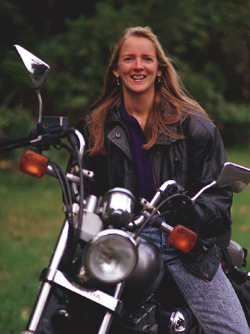
I could tell there was trouble brewing when I arrived at the Nicaraguan border. It wasn’t just the fact that I had to fill out (and pay for) paperwork in Spanish. For that, I had the help of a local teenager whom I couldn’t understand. It paid him well to hang around and help wayward tourists through the border. With my limited Spanish, I depended upon his guidance; get a stamp here, another stamp there, pay that man for your visa, pay yet another for your vehicle. After seven weeks on the road, riding a BMW F650 motorcycle through Central America, I was used to wading through this type of indecipherable bureaucracy at border crossings.
More Motorbike Travel: Tips for Women Riding Motorcycles | What to Wear on a Bike
What had me worried, however, were the occasional snatches of conversation I could understand. It seemed there was some kind of problem ahead. A big problem.
The campesinos — peasants — had threatened to stage a transportation strike. What exactly this meant I was left to determine for myself. In the U.S., it might mean that bus or train service would cease. But the way they were talking made it seem far more serious than that.
Still, the border guards assured me that there would be no trouble for a lone motorcyclist. Famous last words.
Riding away from the border toward the capital city of Managua, I tried to take heart. Maybe it wouldn’t be that bad. After all, I had come this far with few problems.
How it Began
It had all started months earlier, when I devised a plan to take my F650 on a 7,000-mile solo journey from Seattle through the heart of machismo in Mexico and Central America to Panama, where I would fly back to the U.S.
I called the bike Esperanza, “hope” in Spanish, and wondered if riding this bike on Central America’s highways would be more a trial for me or the motorcycle. Regardless, I trusted that Esperanza would be my guardian angel and ensure my safe passage.
To prepare for the trip, I took the off-road riding course sponsored by the Washington state Ready to Ride program; three hours of controlled recklessness in pure mud. Practicing on an 80cc mini-bike wasn’t quite the same as it would be on my F650, but I soon had the basics down; eyes up, elbows out, look lean and roll into the turns.
My first stop was Hansen’s BMW/Triumph in Medford Oregon where I took a crash course (no pun intended) in motorcycle maintenance. When you’re facing a nine-week trip through remote territory, you can never be too prepared. Owner Craig Hansen personally explained the basics of oil, fuel lines, fuses, and how to fix a flat by replacing the tube.
“If you’re prepared for a problem, it won’t occur,” was Hansen’s theory of life.
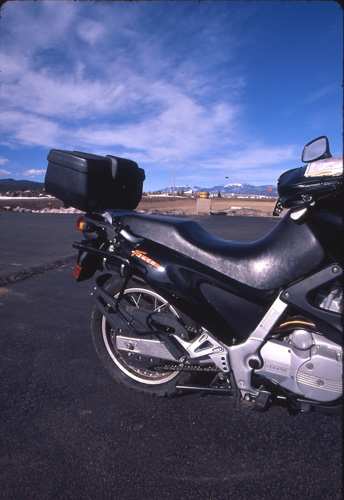
It took me only a few days to test that theory in an unfortunate encounter with a 4-inch nail in a remote area of New Mexico. Remarkably, the bike and I did not hit the pavement, even though the metal was driven directly through the back tire, shredding the tube.
Esperanza with flat tire in New Mexico
Of course, one of the few things I wasn’t prepared with was a spare tube, so I found myself far from help, with all the shops closed on a late Saturday afternoon. Fortunately, I was rescued by Ron, a boat mechanic. As if he were accustomed to biker chicks in distress, he simply ordered a new tube from Albuquerque, 90 miles away, sent his brother to pick it up, and provided me with an overnight loaner car, all for just $100!
While waiting for the repairs, this unsaved soul found spiritual consolation by visiting local churches where the presiding holy men spoke to the congregation in Spanish and English. These visits, I hoped, would provide me with good fortune crossing into Mexico and the rest of Central America, which no less than terrified me.
Perhaps it worked, because clearing Mexican customs was a snap a few days later. I then motored down the main highway through the state of Chihuahua, before cutting west into the thick, green pine forests of the region.
Sola?
My progress was slowed only by the curves along this mountainous route. By late afternoon, I arrived in Creel, a tiny village on the edge of the Copper Canyon region of the Sierra Madres. This is the home to the Tarahumara Indians, the most traditional of all Mexico’s indigenous peoples due to their remote location. Wearing thonged shoes made of old tires, the men visited with each other as the women and children, in giggling clusters, hawked their handcrafted wares.
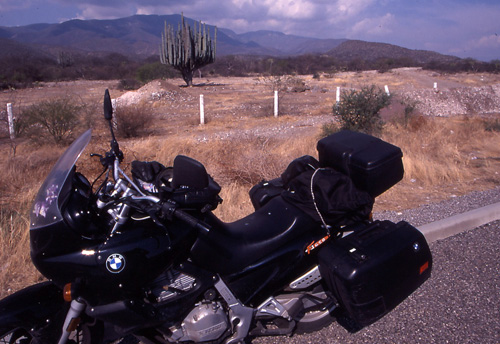
Esperanza with Cactus in Mexico
Heading farther south, at each of Mexico’s state lines, I was stopped at police posts.
“Sola?” The federales asked, wondering if I really was riding by myself.
“Si, sola,” I routinely answered.
Typically, these encounters involved a bit of finesse. With rifles at their sides, one group searched my saddlebag then asked if they could have my Walkman.
“No,” I firmly answered. Then I tried to make light of the situation by adding, “But you can have my peanut butter!” With a twinkle in his eye, one burly federale wanted “regalos”. With legs shaking, I left them behind, later to find in my dictionary that “regalos” meant gifts. Of what nature, thankfully, I never found out.
My Spanish was only barely improving, but I quickly became acquainted with a name I heard myself called throughout Central America; guerita. “Little blondie”, was an affectionate term used by the more (and less) macho to get my attention as I strolled the cobblestone streets, free from my helmet and riding gear.
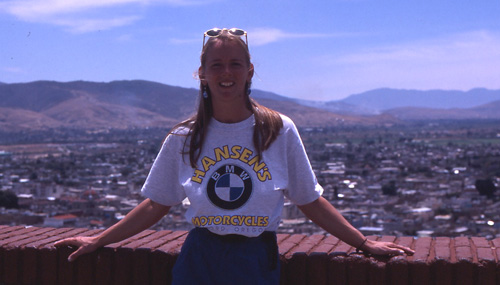
I continued south through the state of Chiapas. With the exception of the constant choking and sputtering of buses, I found the roads ideal for motorcycle touring. Threading my way through switchbacks in the breathtaking mountains and villages, I arrived in the small village of San Cristobal de las Cassas just as Easter weekend festivities were in full swing.
In Central America, Easter is celebrated with as much enthusiasm as a North American Christmas. I found myself caught in parades of children and adults celebrating the resurrection. Sweets were thrown from colorful parade floats as freely as Mardi Gras beads in New Orleans.
Despite the festivities, I couldn’t ignore the fact that Chiapas has the most violent recent history of any state in Mexico. With the country’s largest population of indigenous peoples, Chiapas saw the slaughter of 150 locals in a 1994 protest over the government’s suppression of native Indians. I felt extremely vulnerable on a motorcycle, and it didn’t help that I was about to enter Guatemala, a country that only recently declared peace after a 30-year civil war that left 100,000 dead.
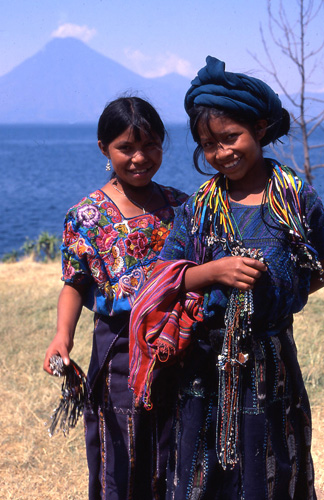
Paradoxically, the Guatemalans seemed anything but threatening. The villagers I met were all wearing brightly colored weavings decorated with woven pinstripes and embroidered flowers.
The stories I’d heard from expatriates and other tourists, though, caused me to keep my guard up. With no civil war to occupy their time, the now-unemployed and still-armed ex-guerillas had taken up thievery as a career choice. I heard stories of pickpockets, robberies, rapes, kidnappings, and murders, often with Americans as targets.
I nervously continued east on the Pan American highway, successfully making it through another border crossing into El Salvador without incident. Once there, I found conditions that proved to be more hazardous than any encounter in Guatemala. But it was the roads, not civil unrest that caused the biggest problems.
I crossed countless dilapidated bridges and followed endless detours. Road construction and gravel-laden highways were the norm. Unlit tunnels were as black as moonless nights. And the paperwork required at the borders was astounding even by Central American standards.
These obstacles tested my patience and riding abilities while I tried to concentrate on smelling the fresh salty Pacific and enjoying the ride. Still, I thought of my prayers in those New Mexico churches and was glad my luck had held so far.
Then I heard the stories of the transportation strike in Nicaragua.
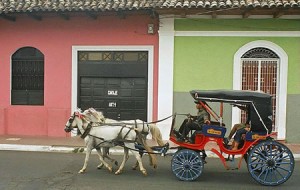 Not knowing exactly what to expect, I rode on to Granada, on the northern shore of Lake Nicaragua. Home to the world’s only freshwater sharks, the lake stretches 80 miles from Granada southeast to the nearby Costa Rican border.
Not knowing exactly what to expect, I rode on to Granada, on the northern shore of Lake Nicaragua. Home to the world’s only freshwater sharks, the lake stretches 80 miles from Granada southeast to the nearby Costa Rican border.
With two weeks left to reach my plane in Panama City, I had hoped to breeze through Nicaragua and spend some quality time relaxing in the tourist haven of Costa Rica. That started looking less likely as I discovered what a transportation strike meant.
Bracing for a Strike
While I was in Granada, I heard tales that every city around was braced for protest, government shutdowns, roadblocks, and possible violence. Hoping the unrest would pass, I settled into my hotel and enjoyed the company of several soon-to-be friends in the form of the hotel’s other guests who were as varied as a Baskin & Robbins menu. Regardless of our differences, we quickly bonded. Meanwhile, the strike went into high gear.
Within days, roads were cordoned off by mobs of people who set up barricades of burning tires and tree logs. Streets were beset by hundreds of campesinos brandishing sticks, not allowing anything through. No one knew how long the strike would last or whether I could circumvent the blockades.
I now had to reach Panama in just over a week — with Costa Rica and hundreds of angry protesters in the way.
As the days ticked down, I found myself unable to hold out for the strike’s uncertain end. Finally, I tentatively packed my saddlebags, bungeed down my camera gear and said farewell to the gang. Through my helmet, I listened to the encouragement of my fellow travelers.
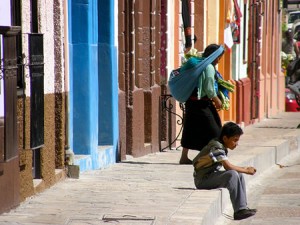 “You go, girl.” “You can make it!”
“You go, girl.” “You can make it!”
I wasn’t so sure.
Doubt
The peacefulness of the town’s deserted streets was misleading. Before I even shifted into third gear on the main road out of Granada, I encountered the protesters.
I was met by a blocked road and a large, intimidating group of locals, their arms folded tightly across their chests, distrust in their eyes.
As luck would have it, an emergency vehicle arrived. While the campesinos busily created an opening by peeling back the logs and branches, I rode through tight on the tail of the ambulance. They tugged at the bike, but I kept moving.
Five miles, ten miles. I felt encouraged. Fifteen miles, twenty miles. Maybe I’d make it to Costa Rica after all.
Then, at twenty-four miles, bad news. A huge crowd had commandeered an intersection. I dismounted as this aggressive-looking bunch approached me, wielding sticks. In my best act of confidence I assured them that I had just come from Granada and that I had been graciously led through many other blockades.
I tried tears and dollars with no success. Even the police were interested only in keeping peace and not in accommodating a gringa offering bribes.
The heaviness of the heat and situation upon my shoulders, I turned back to retreat to my hotel. But once on the highway, my friends’ words of encouragement came back to me; “You can do it!”
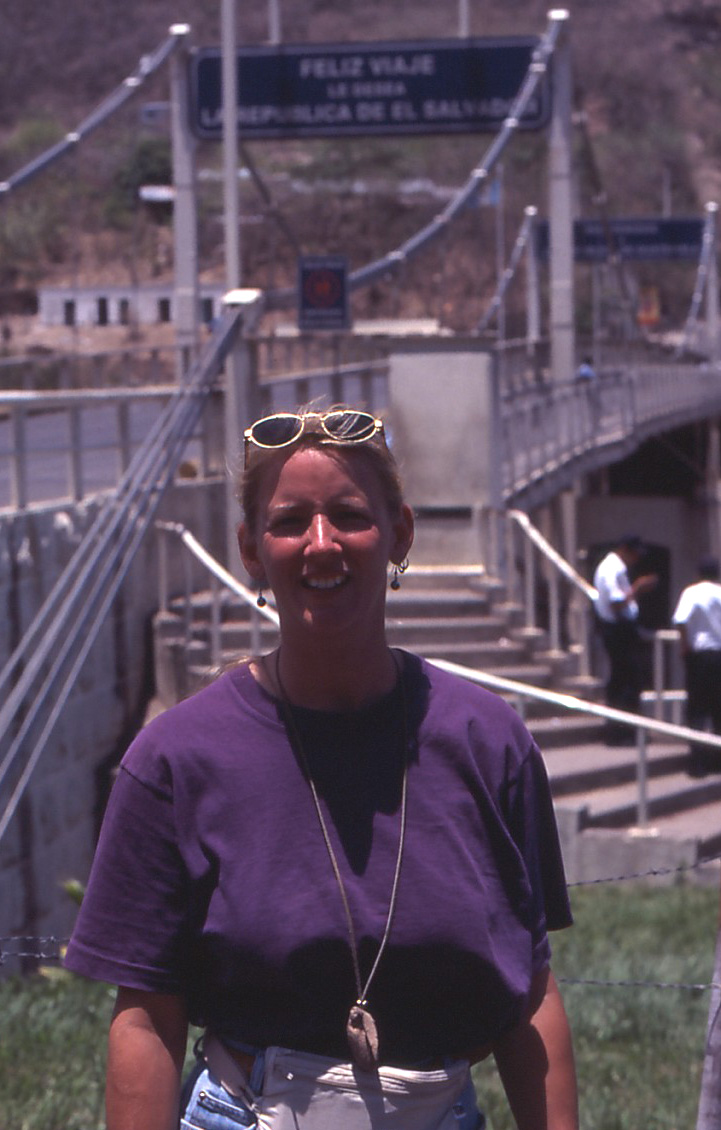
I veered off into a private dirt drive and found myself cruising through cornfields to avoid the campesinos and their burning tires. But I quickly learned that the land had been fenced in, and there was no break in the barbed wire.
I watched as the campesinos began coming after me on bicycles. I was certain I was done for. I accelerated back to the main road, knowing that I had given it my very best effort.
A few miles later, I noticed an approaching motorbike ridden by two young Nicaraguan men. They slowed down to talk and I explained that the roadblocks weren’t letting anyone through. They asked where I was going, and then motioned me to follow them.
It seemed like an eternity, but it was probably only 15 minutes of the hardest riding I had ever done. We rode through six inches of sand, through cornfields and farmland, behind country homes, coming within inches of barbed wire fencing and back doors. Sweat streamed down my face in the 85-degree heat, and my muscles tensed as I struggled to keep the bike upright. We even encountered unpaved roads that were blocked by deep trenches the campesinos had dug.
Through it all, I followed my two compadres. Finally, we came back out on the highway.
Hours later I safely arrived in Costa Rica. The sleepy border police were astounded that I made it through Nicaragua. I was the sole person crossing that day, as all traffic in either direction had been stopped for four days.
Costa Rica, the tourist destination for most travelers to Central America, was lost on me. I spent only two days traversing the country. A combination of incessant gravel roads and bad weather encouraged me to keep moving towards Panama.
I felt sad that I had to pass through so briskly, but found solace in the company of strangers. Waiting out a 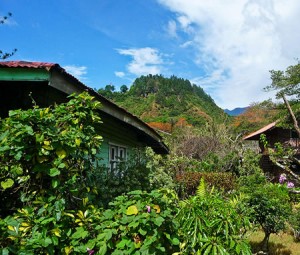 torrential downpour at a covered bus stop 30 miles from Panama’s border, I entertained my bus-waiting companions with an impromptu version of “Singing in the Rain.” “Rain, rain,” they repeated. We all understood.
torrential downpour at a covered bus stop 30 miles from Panama’s border, I entertained my bus-waiting companions with an impromptu version of “Singing in the Rain.” “Rain, rain,” they repeated. We all understood.
In Boquete, a quaint village in Panama’s western mountains, I was surrounded by verdant hillsides and Panama’s only active volcano. This latte lover’s paradise is home to rich soil, high elevation, and warm weather, perfect ingredients for its endless coffee plantations and prolific gardens.
Panama’s charm was not limited to its landscape. The Panamanian motorcycle police evidently hadn’t seen many F650s. They pulled me over more often than the Mexican federales, just to get a closer look at the bike. When I dismounted and pulled off my helmet, they literally jumped back in laughter. Obviously surprised that a woman was riding, they screamed, “Mujer, mujer” – woman, woman. At least I preferred this to “guerita”.
After a brief visit to the Canal Zone, I reluctantly delivered Esperanza to the freighting company that would see her safely back home. She was crated and flown back, taking an incredible two months before arriving in Seattle.
For myself, the trip home took only hours. But it seemed as though I was returning from another world — one in which political difficulties were more than offset by spectacular scenery and new friendships born of chance encounters. And, as I reflected on this incredible journey, I thought of my new friends and the fact that I did “Go, girl.”
Photo credits:
Nicaragua: Délirante bestiole [la poésie des goupils]
San Cristobal: Darij & Ana
Boquette Panama: ex_magician
All other photos courtesy of the author
*****
Beth Whitman is the author of Wanderlust and Lipstick: The Essential Guide for Women Traveling Solo and Wanderlust and Lipstick: For Women Traveling to India. She is also the editor of Wanderlust and Lipstick.